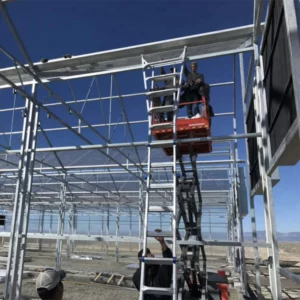How does the size and scalability of Polycarbonate Greenhouses impact its usability?
The size and scalability of polycarbonate greenhouses have significant implications for their usability in agriculture.
Here’s how the size and scalability factors impact the effectiveness and versatility of polycarbonate greenhouses:
- Space Utilization:
- Polycarbonate greenhouses come in various sizes, allowing for efficient use of available space. Smaller units are suitable for limited areas, while larger structures optimize land utilization, making them adaptable to different farming environments and scales.
- Crop Capacity:
- The size of polycarbonate greenhouses directly influences the crop capacity they can accommodate. Scalability allows for adjustments in greenhouse size based on the desired crop volume, supporting the cultivation of various crops and accommodating different production scales.
- Crop Diversity:
- Polycarbonate greenhouses can be scaled and designed to accommodate a diverse range of crops. The ability to customize the greenhouse size and layout supports the cultivation of different types of plants, including vegetables, flowers, herbs, and specialty crops.
- Vertical Farming and Shelving:
- Larger polycarbonate greenhouses can be designed to facilitate vertical farming practices. This includes the installation of shelves or racks, optimizing vertical space and enabling the cultivation of crops in layers. China Polycarbonate Greenhouses supplier Vertical farming enhances space efficiency and allows for the production of larger quantities of crops.
- Adaptability to Growing Methods:
- The scalability of polycarbonate greenhouses accommodates different growing methods, such as hydroponics, aquaponics, and traditional soil-based cultivation. The design can be customized to include features like elevated benches or container systems to support various cultivation techniques.
- Season Extension:
- Larger polycarbonate greenhouses contribute to season extension by providing a controlled environment. The scalability factor allows growers to choose the appropriate size to meet the goal of extending the growing season, enabling year-round production and improving overall efficiency.
- Energy Efficiency:
- Larger polycarbonate greenhouses may include energy-efficient features, such as double-wall polycarbonate panels with insulating properties. This helps maintain a more stable internal environment, reducing energy consumption and enhancing overall operational efficiency.
- Climate Adaptability:
- The size and scalability of polycarbonate greenhouses allow for the customization of climate control systems. This adaptability is important for accommodating different climate conditions, making it possible to create optimal growing conditions for a variety of crops.
- Ease of Expansion:
- Scalability allows growers to expand their production capacity over time. This is beneficial for businesses looking to gradually increase their operations or adapt to changing market demands. The modular nature of polycarbonate greenhouses often makes expansion relatively straightforward.
- Customization for Specific Crops:
- Different crops have varying space and environmental requirements. The scalability of polycarbonate greenhouses enables farmers to customize the greenhouse size, layout, and internal conditions to suit the specific needs of different crops, promoting optimal growth.
- Reduced Environmental Impact:
- The ability to scale greenhouse operations based on demand contributes to resource efficiency. Efficient space utilization and controlled environments help reduce the environmental impact of agriculture by optimizing water, energy, and land use.
In conclusion, the size and scalability of polycarbonate greenhouses play a crucial role in their usability across different agricultural settings. Whether for small-scale or large-scale operations, the adaptability of these greenhouses supports diverse crop cultivation, efficient resource use, and sustainable farming practices.



